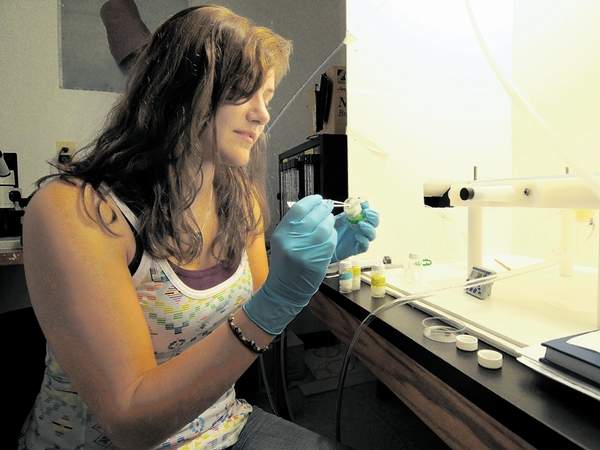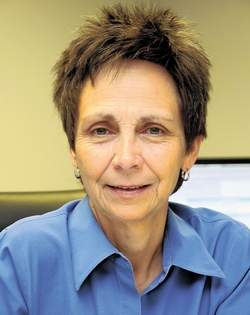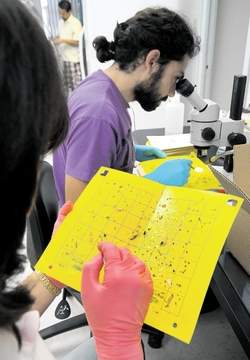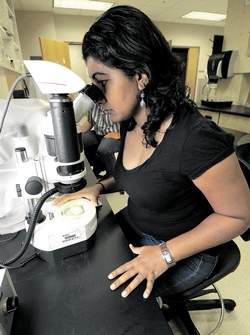http://www.newschief.com/article/20100509/NEWS/5095077/-1/news02?Title=Science-of-citrus-Lake-Alfred-center-stays-at-the-forefront-of-international-citrus-research
Science of citrus - Lake Alfred center stays at the forefront of international citrus research
By CATHY KOPLEN
News Chief correspondent
Published: Sunday, May 9, 2010 at 4:01 a.m.
Last Modified: Sunday, May 9, 2010 at 2:53 a.m.
 Paul Crate / News Chief
Paul Crate / News Chief
Sara Hermann, a research biologist, conducts research on the red ambrosia beetle at the University of
Florida Institute of Food and Agricultural Sciences Citrus Research and Educational Center in Lake Alfred.
Friday, April 09, 2010.
When stepping outside in East Polk County during the spring, it is nearly impossible to miss the heady fragrance of orange blossoms.
The small, white, lacy blooms on the orange trees emit a perfume attracting bees and showing a promise of the fruit to come. The smell, as it waifs through the air, is almost intoxicating; and this year the abundance of blossoms makes the aroma much stronger.
"It is a little reward for suffering through all that cold" said Dr. Tim Spann of the University of Florida Citrus Research and Education Center. "The cold temperature is responsible for the trees having way more blooms than they usually do."
The billion-dollar citrus industry is extremely important in East Polk County. In addition to providing a lovely backdrop and fragment aroma in the spring, orange groves drive a good portion of the area's economy. Florida orange producers are responsible for growing, producing, marketing and shipping the largest quantity of citrus-based products in the world.
"An economic impact study was done in Hillsborough County 10 years ago," said U.S. Rep Adam Putnam of Bartow. "It was found that the citrus industry brings in as much money to the area as if they hosted one Super Bowl per month. Agriculture tends to fly under the radar, it is not as publicized as the Super Bowl being hosted in Tampa, but as far as its economic impact, it is considerable."
This tenuous, agricultural-based income producer is fraught with pests, diseases and weather-related calamities. To combat the difficulties that arise in the industry, citrus farmers and producers rely on the research and development of the University of Florida Citrus Research and Education Center. The center has been instrumental in helping the industry grow and maintain a strong competition in the world market.
"We have a good relationship with citrus growers in California, Texas and Brazil," said Dr. Jackie Burns, director of the center. "In today's global market, we have a healthy competition. It is truly a global economy and we learn from each other. We are careful about sharing, but we understand that what is good for the industry is good for all of us."
The citrus industry has been a major income producer in Central and South Florida for more than 100 years. Citrus farmers began to organize groves of trees producing fruit for market in the early 1900s. Shortly after organizing into a cooperative growers' group, Polk County citrus farmers pooled their money to purchase some land in Lake Alfred for a citrus research center. Called the Citrus Experiment Station, University of Florida personnel agreed to staff the station with a few scientists to assist with citrus research and development.
Much has changed in the citrus industry since the Center's inception in 1917. There are several different laboratories at the Center that focus on the evolving science of citrus farming. In addition, there is a citrus grove, pilot processing plant and the world's largest citrus library. About 250 full-time employees work at the Center.
"Anybody can walk in here and ask a question, and to the best of our ability, we will help them find answers," Burns said. "We also have an outreach designed to inform the consumer and the grower."
The two biggest consumer-driven interests in the citrus industry are the fresh fruit market and the juice market. Both of these areas of production have evolved radically, and the center has been involved in much of the improvements.
It was not until researchers developed the technique for making frozen, concentrated orange juice, that residents around the country could go to a grocery store and buy Florida orange juice. This method allowed processed orange juice to be shipped around the world. In addition, the center has made strides in the way fresh fruit is crated and shipped, as well as improving the integrity of the skin of the citrus fruit to allow for less bruising and loss when it is shipped.
A more recent development in the citrus industry is the flash-pasteurized fruit juice that allows consumers to enjoy a fresh squeezed flavor. These juices, packaged in cartons with clearly marked expiration dates, are found world-wide in the refrigerator section of grocery stores and markets. They have a shorter shelf life than the frozen concentrated juice; however the stream-lined shipping and delivery methods have allowed these fresh-tasting juices to be profitable to Florida growers and processors.
"The fresh-squeezed juice was a push from the industry," Burns said. "Fresh juice tastes better than processed juiced."
Another development in the citrus industry is the method the growers use to induce the fruit to show its potential colors. In Florida, the ripe fruit often shows green, although the interior of the fruit is ripe and ready to consume. A process, called gassing the fruit, uses ethylene to "trick" the fruit into changing colors.
"In a subtropical climate like we have here in Florida, where we do not get cool nights, we do not get the good, bright colors - like the vibrant orange and yellow - which occur naturally in the fruit," Burns said. "In California, where you get warm days and cool nights, you get prettier fruits. In the fresh fruit market, when the consumer is looking at fruit from California and our fruit, the consumer will choose the prettier fruit. It puts us at a disadvantage, although our fruit is perfectly ripe and, I think, tastes better. We use ethylene. We give the fruit a little bit of that and it causes the fruit to change colors. It occurs naturally, but it has to be cooler at night for it to occur."
The center also has been active in pest and disease prevention, as well as fruit nutrition and irrigation. Staffers continue to modify the test grove and have discovered ways to prunes the trees that allow for the highest yield. In the center laboratories, new strides in better fruit, production, packaging and products are continuing to emerge.
 Dr. Jackie Burns, Interim center director
Dr. Jackie Burns, Interim center director
and professor, at the University of Florida
Institute of Food and Agricultural Sciences
Citrus Research and Educational Center in
Lake Alfred. Friday, April 09, 2010.
Paul Crate / News Chief
 Lab technicians, Angel Hoyte, left foreground,
Lab technicians, Angel Hoyte, left foreground,
and Ruben Blanco look for Asian citrus psyllid, a
destructive pest, in the entomology lab at
University of Florida Institute of Food and
Agricultural Sciences Citrus Research and
Educational Center in Lake Alfred.
Friday, April 09, 2010.
Paul Crate / News Chief
 Swapna Mony, a senior biological scientist,
Swapna Mony, a senior biological scientist,
conducting research on citrus canker in the
pathology lab at the University of Florida
Institute of Food and Agricultural Sciences
Citrus Research and Educational Center in
Lake Alfred. Friday, April 09, 2010.
Paul Crate / News Chief
 Diane Bright, a senior biological scientist,
Diane Bright, a senior biological scientist,
conducting research on ribonucleic acid in the
pathology lab at University of Florida Institute
of Food and Agricultural Sciences Citrus
Research and Educational Center in Lake Alfred.
Friday, April 09, 2010.
Paul Crate / News Chief 







